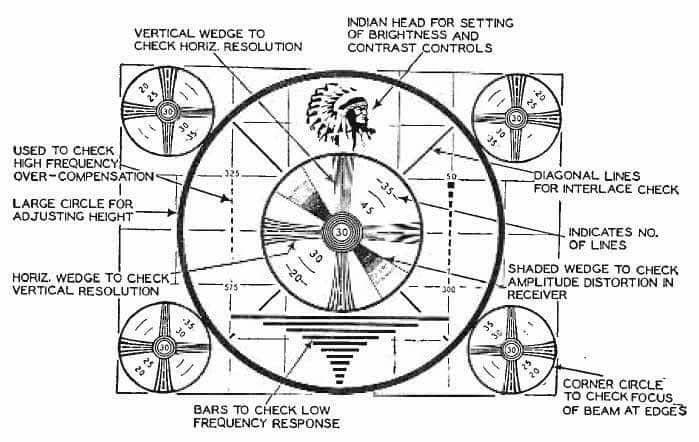What was the purpose of that Indian head thing on TV?
By Morf Morford
Tacoma Daily Index
Back in the distant past, when the world was analog, and human beings, not machines, made things, and fixed things, and in this case, calibrated things, there were indicators all over the world that things were being done and even cared for.
There were people, even doctors, that would routinely come to the home of a sick person. (1*)
The early days of television, even though in black and white, seemed nothing short of miraculous.
Those early days, up until the end of the 1950s, were called by most media professionals, “the golden age of television”.
There were few rules and no formulas. Brash actors and writers explored the new medium and made their own way.
Many, if not most of them, had established careers in radio and many (though not all) made their way into the demanding – and wide open – visual world of television.
Much of prime time (though no one used the term back then) was broadcast live. You could see live performances of dramas, Broadway musicals and concerts of all kinds.
Many of these broadcasts were not filmed so were a pure contemporaneous experience.
Some were filmed and the quality of performance is astounding – though, by our standards, the sound and visual acuity (and certainly the limits of fixed cameras) makes them look amateurish if not clumsy.
Many actors took on characters that defy both current assumptions of propriety and our sense of how “tame” the 1950s were.
Cross-dressing (especially by Milton Berle) was a common “schtick” (a Yiddish term used to describe a comic performance or routine). Flamboyantly arrayed characters like Liberace were standard fare on ’50s TV.


To calibrate sound quality, the test pattern was usually accompanied by a 1,000 or 400 hertz sine wave test tone, which demonstrated that the TV aural receiver was working. If the tone was pure-sounding rather than a buzz or rattle, then transmitted speech and music would not be distorted.
Talent and variety shows were common (and again, mostly broadcast live).
These ranged from topical/absurdist improv shows like Your Show of Shows – which featured Sid Caesar, Imogene Coca, and Carl Reiner in this comedic, unpredictable if not anarchic 90-minute variety show that aired from 1950 to 1954 (TV Guide ranked this at 30 in its list of “50 Greatest TV Shows of All Time”) and my childhood favorite, The Red Skelton Show; this variety show reigned as one of the most popular TV programs for 20 years, from 1951 to 1971. Hosted by legendary comedian and clown Red Skelton, it featured guest stars, comedy sketches, music performances, and more. Red Skelton made a point of avoiding mean or crude humor and was a master of profiling the plight of the typical person besieged by the stresses of modern life.
The Philco Television Playhouse – was a highly respected and hugely popular dramatic anthology series aired on NBC from 1948 through the first half of the ’50s. This program received numerous awards for its adaptations of Broadway plays and musicals.
Arthur Godfrey’s Talent Scouts – which ran from the late ’40s up to the end of its run in 1958, featured Lenny Bruce (!) among many others artists and figures that would dominate TV, radio and all of popular culture for a generation or more.
The Ed Sullivan Show – Began in 1948 as The Toast of the Town and renamed in 1955 is probably the most famous television variety show in history. It ran continuously until 1971, and besides introducing America, if not the world, to acts as varied as Topo Gigio the performing mouse (http://www.edsullivan.com/topo-gigio-the-ed-sullivan-show-mouse/) various plate spinners and, of course, The Beatles. (2*)
Other memorable shows included Gunsmoke, Dragnet, The Honeymooners (which featured Jackie Gleason, Art Carney, and Audrey Meadows; only ran from 1955 to 1956, but was honored for being TV Guide’s third-greatest television show of all time), The Lone Ranger and the irrepressible I love Lucy.
Far from being bland, the 1950s in America set standards in every arena, from fashion, film and cars that will never be matched. (3*)
Even though it might seem that 1950s was exclusively white, Nat King Cole was the first African-American to host his own series – http://www.classictvinfo.com/TheNatKingColeShow/.
As the decade came to an end, new shows were introduced. Dobie Gillis, Rawhide and The Twilight Zone all started in 1959. You can see many of these classic TV shows here – http://www.classic-tv.com/shows/decade/1950s.
(1*) As I think about it, the idea of compelling sick people to go to a hospital or ER seems like the worst thing you could do for the patient – and the absolutely best way to spread disease among those with weakened immune systems.
(2*) But not Bob Dylan. Dylan was to perform on May 12, 1963, but cancelled at the last minute after the dress rehearsal, when Sullivan asked him to perform a different song or change the lyrics to “Talkin’ John Birch Paranoid Blues”.
(3*) To get an overview of the 1940s and 1950s, from candy to culture, I suggest this website – http://www.heywoodwakefield.com/category/spotlight-on-mid-century-modern/.








